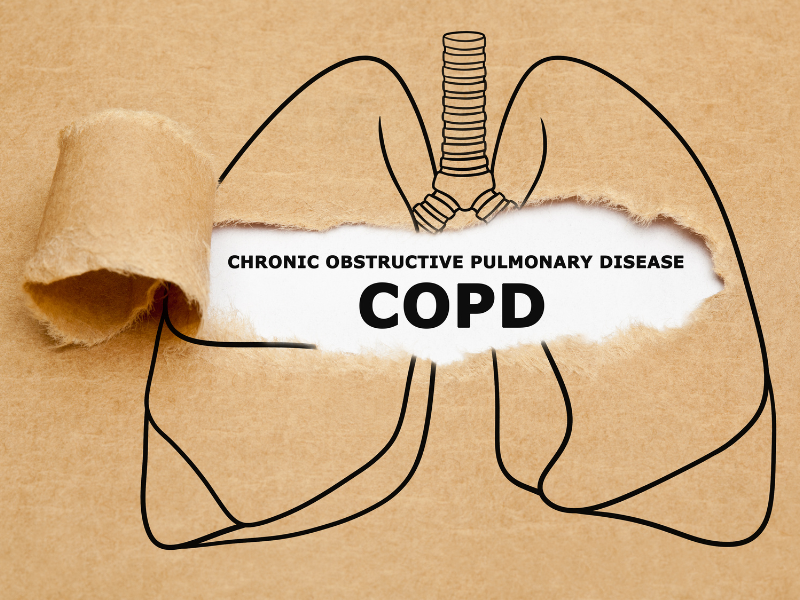Chronic Obstructive Pulmonary Disease (COPD)

Chronic obstructive pulmonary disease (COPD) is a class of disorders that encompasses chronic bronchitis and emphysema. COPD gradually makes it more difficult to breathe. Although lung damage is irreversible, lifestyle and medication changes can help manage symptoms.
What is COPD?
Chronic Obstructive Pulmonary Disease (COPD) is a chronic inflammatory lung disease that results in blocked airflow from the lungs. It is a progressive disease, which means it will worsen over time. COPD includes two main conditions:
· Chronic bronchitis- Chronic bronchitis irritates bronchial tubes, causing swelling and mucus buildup. This narrows the air passage.
Normally, hair-like structures called cilia clear mucus from airways. However, chronic bronchitis or smoking damages them, hindering mucus clearance.
· Emphysema- Emphysema involves the breakdown of alveoli in the lungs. Alveoli work by transferring oxygen into the blood and carbon dioxide out. Emphysema damages alveolar walls, impeding full breaths.
These two conditions often occur together and can range in severity in COPD patients.
Causes of COPD
The primary cause of COPD is long-term exposure to irritants that damage the lungs. Smoking is the leading cause of COPD, responsible for up to 90% of COPD cases. Other causes of COPD include:
- Secondhand smoke: Exposure to secondhand smoke can increase the risk of developing COPD.
- Air pollution: Exposure to polluted air, both indoors and outdoors, can contribute to the development of COPD.
- Chemical fumes: Chemical fumes like those found in certain workplaces can increase the risk of developing COPD.
- Dust: Dust such as those found in coal mines can increase the risk of developing COPD.
- Genetics: A small percentage of people with COPD have a hereditary disease known as alpha-1 antitrypsin deficiency. This can increase the chance of developing emphysema.
Symptoms of COPD
The symptoms of COPD often develop gradually and worsen over time. Common signs and symptoms include:
- Chronic cough
- Wheezing
- Shortness of breath, especially during physical activity
- Chest tightness
- Fatigue
- Frequent respiratory infections
- Unintended weight loss
As the disease progresses, individuals may experience exacerbations, marked by severe worsening of symptoms and increased risk of complications.
Treatment of COPD
There is no cure for COPD. However, there are treatments to help manage symptoms, slow the progression of the disease, and improve quality of life.
Treatment options for COPD include:
- Smoking cessation: The most crucial step in managing COPD is quitting smoking to slow down disease progression.
- Medications: Bronchodilators, inhaled steroids, and combination inhalers can help open the airways. Medications can also reduce inflammation in the lungs.
- Oxygen therapy: Oxygen therapy can help improve oxygen levels in the body.
- Pulmonary rehabilitation: This comprehensive program includes:
- exercise training
- education
- behavioral interventions
- Surgery: Lung transplantation is an option for some people with severe COPD.
Prevention of COPD
The best way to prevent COPD is to avoid smoking and exposure to lung irritants. If a person smokes, quitting smoking is the most effective way to reduce their risk of developing COPD.
Avoiding secondhand smoke and air pollution can also help reduce the risk of COPD. Wearing protective gear, such as masks and respirators, can help protect against chemical fumes and dust in the workplace.
Chronic inflammatory lung disease (COPD) results in restricted lung airflow. It is a progressive disease that can make it difficult to perform daily activities.
While there is no cure for COPD, treatment can help manage symptoms, slow the progression of the disease, and improve quality of life. The best way to prevent COPD is to avoid smoking and exposure to lung irritants. If a person smokes, quitting smoking is the most effective way to reduce their risk of developing COPD.



